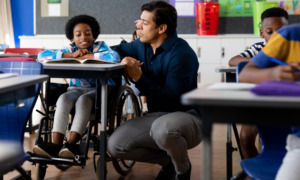Treyce d’Gabriel says she can tell a lot about a kid from a note he scrawls or his handwritten laundry list. She says she can even use that power to change that youth’s behavior.
Changing the curl of a youth’s “g” to keep him from committing crimes?
While juvenile justice advocates push for more spending on evidence-based strategies for helping young offenders, the state of Texas will see if d’Gabriel can use her controversial alternative treatment to help youth on probation avoid further trouble with the law.
The strategy, called handwriting formation therapy (HFT), is not yet backed by direct scientific evidence. Its nay-sayers equate the practice with astrology and palmistry.
But the prospect of a successful (and dirt-cheap) way to lower recidivism was enough for the Texas Juvenile Probation Commission (TJPC) to accept a free trial.
“What is the harm of trying?” asks Judy McGuill, the chief juvenile probation officer for Refugio County, home of 7,600 people north of Corpus Christi. “If nothing is working that much, I’m fixing to try a new program.”
Others in juvenile justice bemoan the project as a scheme to help states cut corners and costs.
“We don’t want to discourage agencies from innovation,” says Dan MacAllair, executive director of the San Francisco-based Center on Juvenile and Criminal Justice. But the juvenile justice field “spends more time looking for alternatives than investing in what works. That sounds like what this is.”
Do Signatures Speak?
Handwriting analysis, also known as graphology, was introduced in America in the 1960s by European researchers, according to the American Handwriting Analysis Foundation. Graphologists believe that certain aspects of a person’s writing style are indicative of personality or behavioral traits. A person who writes with a leftward slant represses emotional feelings, d’Gabriel says; a capital “I” crossed with a phallic shape at the top reveals the baggage carried by victims of sexual abuse.
HFT practitioners believe the phenomenon works in reverse as well: Changing the way people write, d’Gabriel contends, can help them stop certain negative behaviors.
D’Gabriel says she was drawn into the line of work in 1987, when she was in an abusive marriage at the age of 18. “I couldn’t even leave the house alone,” she says.
She says a friend of her father, Charles Stahl – who had run the San Francisco School of Handwriting Studies – gave her handwriting exercises designed to build her confidence. “It gave me enough courage to get up and leave,” she says.
She says she worked with Stahl, then began to do handwriting analysis for law enforcement. The Central Texas Council of Government, which offers law enforcement training, and the Southern States Correctional Association confirmed that they have worked with d’Gabriel.
New to Juvenile Justice
Few people if any in youth work appear to have heard of handwriting analysis for therapy. Three Texas child advocacy groups – the Texas Coalition Advocating Justice for Juveniles, Texas Network of Youth Services and Texans Care for Children – say they know about the project in their state.
Told about the project in an e-mail from Youth Today, Delbert Elliott, director of the Center for the Study and Prevention of Violence, responded, “There are so many crackpot theories that come through this field. … You get what you pay for.”
One psychologist who has taken an interest in graphology is Barry Beyerstein, a professor at Simon Fraser University in British Columbia. He is not a fan.
“There is no evidence that handwriting relates to any kind of personality traits,” he says.
To Beyerstein, the practice is no more scientific than palm reading or fortune telling. Graphology would be “touchingly naïve, even comical, were it not for the fact that these self-styled experts offer advice where it can seriously affect people’s reputations, well-being and economic status,” Beyerstein wrote in his book, The Write Stuff. He says graphologists offer their services to parole boards and companies seeking information about potential employees.
It isn’t that all handwriting analysts are scam artists, Beyerstein says. “They are true believers,” he says.
D’Gabriel bristles at Beyerstein’s criticism. “I offered to do his full profile and show him that he just has not experienced it from a properly trained analyst. He never answered me.”
She provided what she called “quickie” handwriting analyses for two Youth Today staffers, based on a couple of handwritten sentences from each. One of them believed the analysis was very accurate; the other thought it was partly accurate and partly off.
D’Gabriel lists pages of studies that she says validate handwriting analysis. One, a 1995 study by clinical psychologist Ron Kraus, found that properly trained graphologists could produce patient personality profiles that were as valid as those done by psychologists who administered a standard battery of tests.
When it comes to changing behavior by changing handwriting, however, the majority of the clinical world appears to side with Beyerstein.
“This is clearly not a studied or standardized treatment modality for juvenile populations,” says Joseph Penn, a child psychiatrist at Bradley/Hasbro Children’s Research Center in Providence, R.I., who specializes in juvenile justice.
The Texas Experiment
The Texas pilot project is the first attempt at handwriting formation therapy in a correctional setting, d’Gabriel says. The pilot is small: three boys and three girls, ages 14 to 17, from several counties. They are locked up for different reasons. D’Gabriel is not supposed to meet them or know their names during the therapy. Some will receive other services as well, such as more traditional therapy.
D’Gabriel is doing the project at no charge. She says her usual fee for therapy is $1,200 for two years of treatment.
The only criteria for selection, she says, was that the youths had to be on probation between January and August, and “they had to want to change. It’s just like any other therapy: If they don’t want to do it, it won’t work.”
“I’ve seen Treyce’s handwriting analysis work, and it’s impressive,” says Vicki Spriggs, a close friend of d’Gabriel’s who is also executive director of the Texas Juvenile Probation Commission.
D’Gabriel’s first step was to analyze the youths’ handwriting samples. “Some of them wrote lyrics to a song; some people wrote poems,” d’Gabriel says. “My request was nothing revealing, so I could stay objective.”
She now sends the youths handwriting exercises to work on daily. The exercises help the youths change specific parts of their handwriting – the way they slant the letters, for example, or how they cross a “t.” Participants will continue the therapy until August, after which the youths will be tracked for evaluation for one year, Spriggs says.
The approach does not lack for skeptics. “If there’s anything dumber than graphology itself, it’s thinking you can give people better behavior through it,” Beyerstein says.
Even some handwriting analysts do not buy into the therapeutic value. “Some graphologists believe wholeheartedly in it, some don’t at all,” says Heidi Harrington, president of the American Handwriting Analysis Foundation. “I’d say I’m on the cautious side.”
Spriggs’ defense is simple: “The work is being done for free, and it is completely noninvasive. What could we possibly have to lose?”
“If six of six don’t recidivate,” Spriggs continues, “we’ll talk about spending money on a larger project.” She says d’Gabriel would be paid to conduct HFT with 100 juvenile offenders.
D’Gabriel says she has been contacted by officials in Mississippi and Louisiana to run similar projects with juveniles.
At least one probation officer says the therapy has yielded results with a youth. “He has done exceptional with it,” says McGuill, the chief probation officer in Refugio County. “He hasn’t missed a day writing, and his attitude and grades have improved tremendously.”
McGuill knows there isn’t a lot of evidence to back up the strategy, and she couldn’t care less. “Sending them to counselors ain’t working for me,” she says. “There’s got to be some other answers, so I’m willing to try new things.”
Contact: D’Gabriel at (512) 330-9365, www.treyce.com.





























